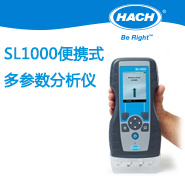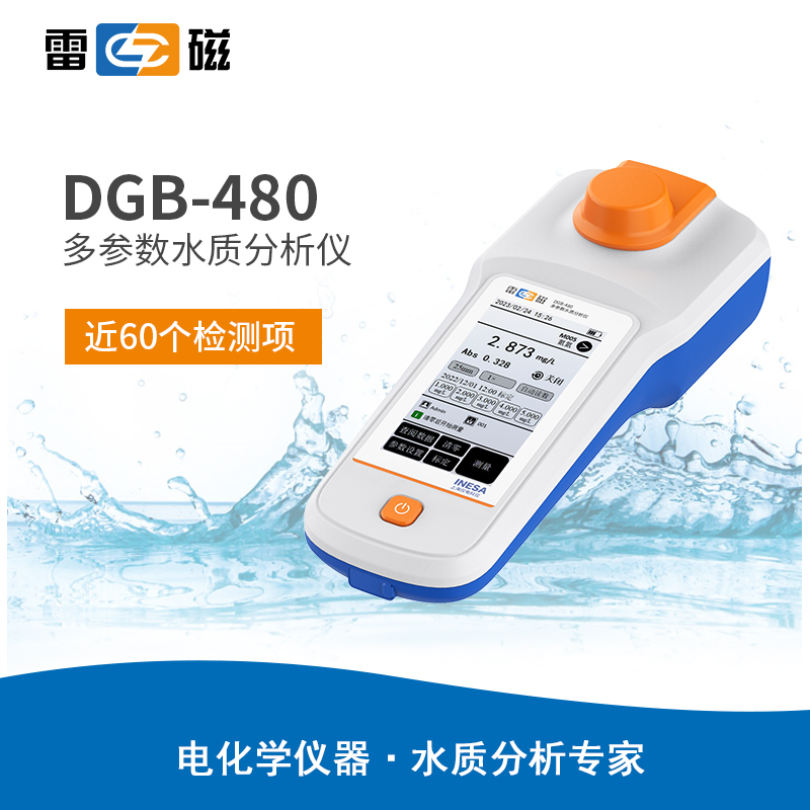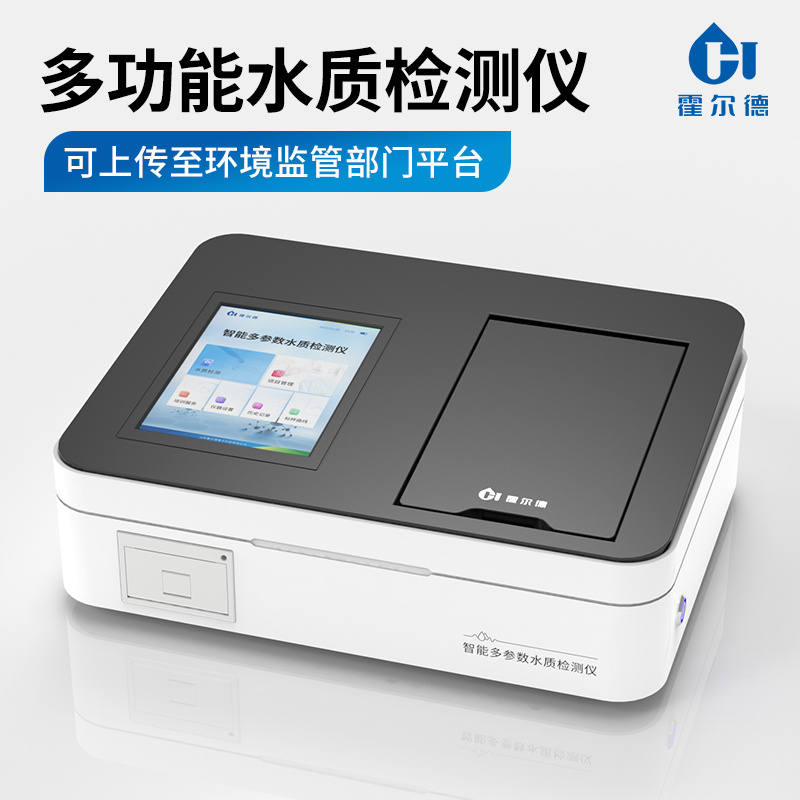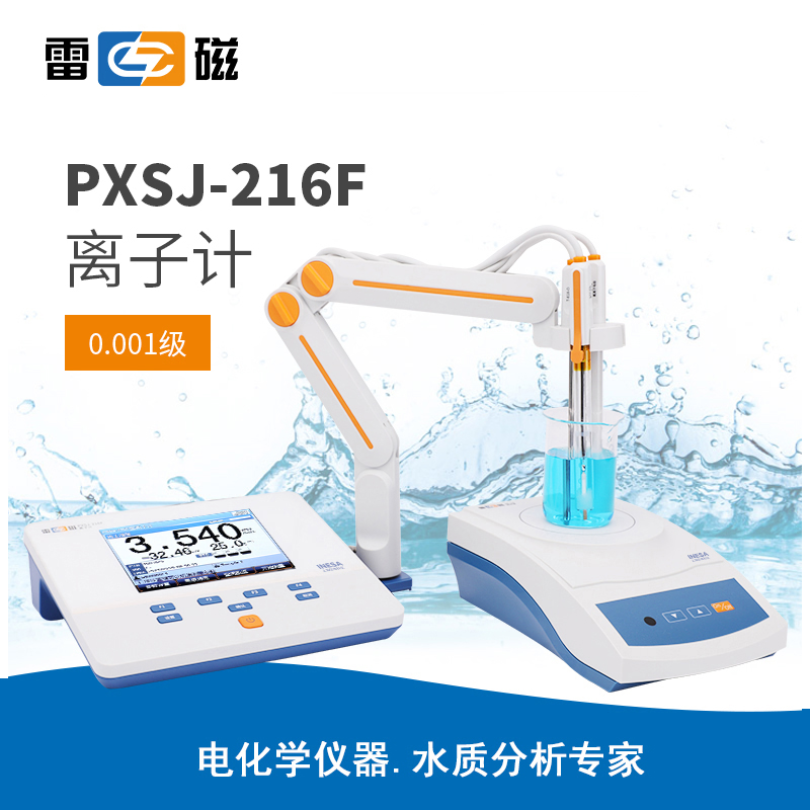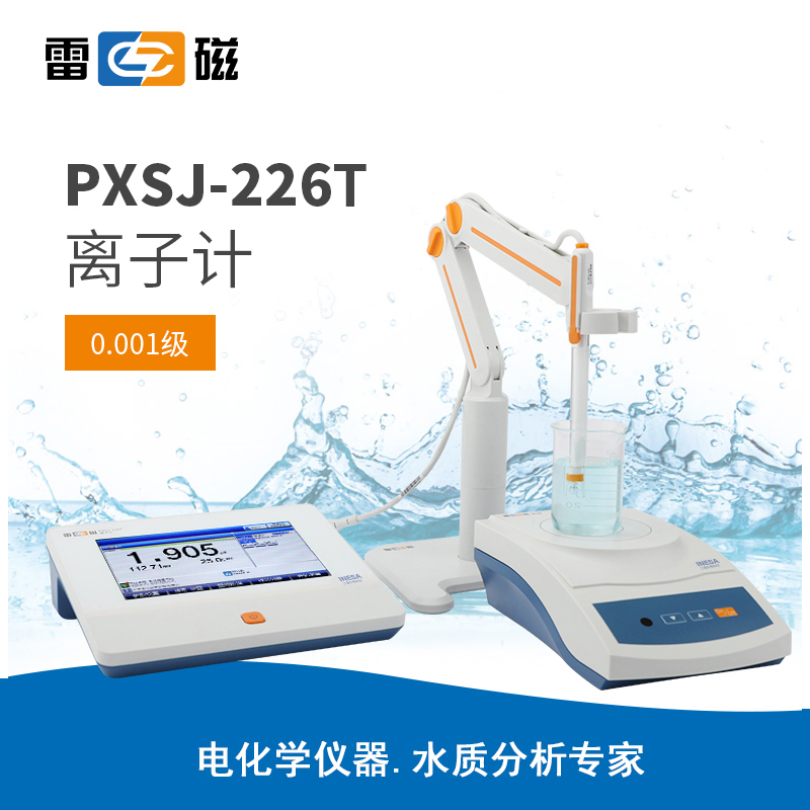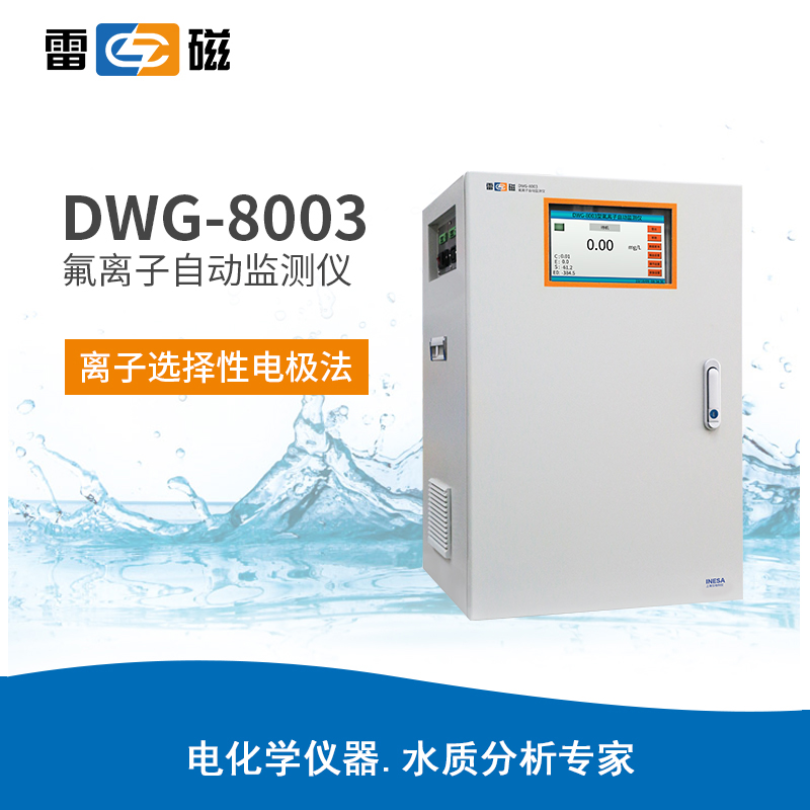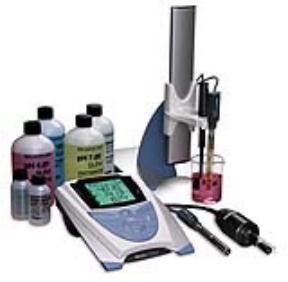
方案详情
文
本文章详细介绍了葡萄酒/啤酒中钾离子的测定,包括校准液、水样的准备,校准和测量过程,以及电极和仪表的维护等内容。
方案详情

Potassium inWine Star SeriesMethod Note M-1410-E 03/05 RevB Potassium inWine 10. Press the LINE SELECTION key to select the middle line, and press the DOWN arrow key to Key Words Introduction select“Unit”. 11. Press the LINE SELECTION key to select the bottom line. Press the UP or DOWN arrow keys to select“mg/L”for“Unit". Press the LINE SELECTION key to accept value. This method provides rapid, uncomplicated determinations of the potassium ion in wine/beer. Thedirect measurement of ions using ion selective electrodes is a well-established technique frequently usedas a standard method of analysis, as a quality control step and to fulfill labeling requirements. 12. Press the MEASURE key to return to the measurement mode. Recommended Equipment Cat. No If all steps were followed correctly the meter display will show three digits in the top line and“ISE: mg/L”to the right of the top line. The meter and electrode are now ready for calibration. Note: The Orion Benchtop Stirrer must be turned on in General Instrument setup before analysis,please see the Quickstart guide for instructions. ·Potassium·Wine/Beer·Orion ionplus@Sure-Flow@plastic membranecombinationPotassium lectrode Calibration and Analysis 1. Allow all the standards and the samples to attain room temperature for precise measurements since themeasurement is temperature sensitive. 2. Calibrate the meter using the 39 ppm followed by the 390 ppm standard, stirring the standards at a gentleand uniform rate. 3. Place the electrode and stirrer into the beaker with the 39 ppm standard such that the electrode tip is fullyimmersed in the solution. The stirrer should be positioned slightly below the tip of the electrode. Press theSTIRRER key on the meter to turn the stirrer on. Press the CALIBRATE key. 4.Wait for a stable reading (1-2 minutes). Enter the standard value of“39”using the UP and DOWN arrowkeys and the DECIMAL/DIGIT key. 5.Press the CALIBRATE key to accept the 39 ppm standard and press the STIRRER key to turn the stirreroff. 2.ionplus potassium electrode 9719BNWP 3. Orion benchtop stirrer (or magnetic stir plate and bar) 096019 4.Orion benchtop Electrode Stand 1110001 Beakers (50 mL) Graduated cylinder (5 mL and 50 mL) Pipettes (1 mL, 5 mL, and 10 mL) Volumetric flasks (100 mL) Vacuum pump (only for beer sample) Required Solutions Cat.No. 1. 0.1M potassium standard 921906 2.ISA (Ionic Strength Adjuster) for potassium electrode 931911 2.Reference Filling Solution, Optimum Results"E 900065 6.Rinse electrode and stirrer thoroughly with deionized water. Gently remove excess solution from the outersleeve of the electrode by dabbing with a clean paper tissue. Do not wipe or rub the sensing element of theelectrode. 4.Deionized water 7. Place the probes and stirrer into the beaker with the 390 ppm standard such that the electrode tip is fullyimmersed in the solution. The stirrer should be positioned slightly below the tip of the electrode. Press theSTIRRER key on the meter to turn the stirrer on. Calibration Standard Preparation 1.To prepare a 390 ppm potassium standard, pipette 10 mL of the 3900 ppm (0.1 M) of potassium standardinto a 100 mL volumetric flask. Dilute to the mark with the deionized water. Mix well. 8.Wait for a stable reading (1-2 minutes). Enter the standard value of“390”using the UP and DOWN arrowkeys and the DECIMAL/DIGIT key. 2.To prepare a 39 ppm potassium standard, pipette 10 mL of the 390 ppm of potassium standard prepared 9.Press the MEASURE key to accept the 390 ppm standard and to move to the measure mode of the meter.Press the STIRRER key to turn the stirrer off. above into a 100 mL volumetric flask. Dilute to the mark with the deionized water. Mix well. 3.Calibration standard preparation, use graduated cylinder measure 30 mL the prepared stds 39 ppm or 390 10. Rinse electrode and stirrer thoroughly with deionized water. Gently remove excess solution from the outersleeve of the electrode by dabbing with a clean paper tissue. Do not wipe or rub the sensing element of theelectrode. ppm potassium standard into each 50 mL beaker. Pipette1 mL of the potassium ISA into the same beaker. Wine Sample Preparation 11. Place the probes and stirrer in a prepared sample with the electrode tip fully immersed in the solution. Pressthe MEASURE key on the meter; the stirrer will turn on. The ISE: ppm icon will flash as the measurementis being made. The ISE: ppm icon will become solid and the display value will freeze when a stable readingis achieved. This value is logged and printed automatically and the stirrer turns off automatically. 1. Pipette 5 mL wine sample and 1 mL of the potassium ISA into a 50 mL beaker, Use graduated cylinder, measure 25 mL deionized water into the same beaker. Results 12. Repeat steps 10 and 11 for additional samples. Upon completion of samples, rinse electrode with deionizedwater and store the electrode according to instructions in the Electrode Storage section of this method note. Five aliquots of prepared wine sample were measured for potassium. The data in the table below is representative of the results expected for potassium in wine. Environmental Instruments ( Water Analysis Instruments 1 66 Cummings C enterBeverly, MA 01915 USA M - 1 4 10-E 03/05 R evB. 248102-0 0 1 ) Toll Free: 1-800-225-1480Tel:1-978-232-6000Dom. Fax:1-978-232-6015IntlFax:978-232-6031www.thermo.com/waterO 2005 Thermo Electron Corporation RegisteredIS O9001:2000 All rights reserved Potassium inWine Prepared Wine ppm (mg/L) Potassium Sample #1: 90.0 Sample #2: 92.0 Sample #3: 90.0Sample #4: 91.0Sample # 5: 91.0 Mean: 90.8 Standard Deviation: 0.84 %CV: 0.92 Note: the average result of the pom potassium in wine was obtained by multiplving the aboveby the dilution ratio of5. The final average result was 454 ppm potassium in wine. Electrode Storage For brief storage periods between sample measurements, store the electrode in 0.01 M potassium standard. The fill solution in the potassium electrode should not be allowed to evaporate, causing crystallization.For longer storage periods, refer to the electrode instruction manual. For potassium electrodes that do not performwell, disassemble and reassemble the electrode, taking care not to over tighten the cap. If the electrode still does notperform as described, replace the sensing module and repeat the slope check. If the slope check still fails, replace theelectrode handle. Beer Sample Preparation 1. Use vacuum pump, degas the beer sample for 20 min. 2.Pipette 5 mL of the degassed beer sample and1 mL of the potassium ISA into a 50 mL beaker. Use graduatedcylinder, measure 25 mL of the deionized water into the same beaker. Results Five aliquots of prepared beer sample were measured for potassium. The data in the table below isrepresentative of the results expected for potassium in beer. Prepared Beer ppm (mg/L) Potassium Sample #1: 90.0 Sample # 2: 92.0 Sample #3: 90.0 Sample#4: 91.0 Sample #5: 91.0 Mean: 40.2 %CV: Standard Deviation: 0.842.08 Note: the average result of the ppm potassium in beer was obtained by multiplying the aboveby the dilution ratio of5. The final average result was 201 ppm potassium in been Electrode Storage For brief storage periods between sample measurements, store the electrode in the 0.01 M potassium standard. Thefill solution in the electrode should not be allowed to evaporate, which causes crystallization. For longer storageperiods, refer to the electrode instruction manuals. Potassium electrodes, whose does not perform well, disassembleand reassemble the electrode, taking care not to over tighten the cap. If the electrode still does not perform as described, replace the sensing module and repeat the slopecheck. If the slope check still fails, replace the electrode handle. Equipment Setup Electrode Setup-ionplus"Potassium Combination Electrode 1. Remove the sensing module from the vial. Make sure both o-rings are in place. Take the handle from the box. 2.Take the outer body sleeve, with the fill hole end towards the white cap, and gently push the inner stem throughthe body. 3.Slide the outer body sleeve, spring, and cap down the electrode cable until the body sleeve is beyond the innerstem. 4.With one hand grasp the middle of the inner stem without touching the reference pellet. With your other hand,screw the sensing module onto the stem until it stops and the module is flush against the stem. Then tighten anadditional one-quarter turn and stop. Do not continue to over tighten. The module should be firmly attached tothe stem. 5. Holding the electrode cable, slide the outer body, spring and cap over the inner stem. 6.Grasp the outer body sleeve, do not touch the sensing membrane. With your other hand, pull on the cable andgently screw the cap onto the inner stem. Stop when an opposite force is felt. Do not over tighten or continue toturn the cap! The cap will not completely stop! If the inner body turns at all, the cap is too tight. Remove the capand reassemble. 7H.old the electrode with one hand. Press on the top of the cap with you thumb to make sure the electrode has asmooth flushing motion and reseats back onto the module. 8.Fill outer body with Optimum Results"" E filling solution to approximately 1/4 full. 9.P1ress cap to flush out the solution. Release the cap and ensure that the outer body sleeve returns to its originalposition. 10. Refill the electrode with Optimum Results"E filling solution until the fluid level is just below the fill hole. 11. To ensure electrode continuity, grasp the outer body and cap and shake the sensing module end firmly. Check tomake sure the membrane surface is dark and homogeneous with no bubbles on the inner surface. Meter Setup-4 star benchtop For initial meter setup, follow the steps in the Quick Reference Guide, which is attached to the meter itself. TheQuick Start Guide included with each meter also contains a layout of the meter keypad for reference. The words inthis method represented in all capital letters, such as POWER, indicates a key on the meter, and words in quotationssuch as “Unit"indicates information on the meter display. 1. Connect the electrode to the meter. 2. Connect the stirrer to the meter. 3P.ress the POWER key on the meter to turn the meter on. 4.Note that the arrow on the left of the screen indicates the active line. If the top line is not active, press the LINESELECTION key to change the selected line to the top line. Then press the UP or DOWN arrow keys tochange the measurement mode of the top line to ISE. 6.Press the LINE SELECTION key to select the middle line, and press the DOWN arrow key to select “nL ln"which is an abbreviation for non-linear blank correction. 7.Press the LINE SELECTION key to select the bottom line. Press UP or DOWN arrow keys to select “off”for“nL In". Press the LINE SELECTION key to accept value. 5P.ress the SETUP key to enter ISE setup. Press the LINE SELECTION key to select the bottom line. Pressthe UP or DOWN arrow keys to select“2”for“rES”which is an abbreviation for resolution or number ofsignificant digits. Press the LINE SELECTION key to accept value. 8. Press the LINE SELECTION key to select middle line, and press the DOWN arrow key to select “rAng”whichis an abbreviation for measurement range. 9 Press the LINE SELECTION key to select the bottom line. Press the UP or DOWN arrow keys to select"HigH” for “rAng”. Press the LINE SELECTION key to accept value. www.thermo.com of of of of
确定
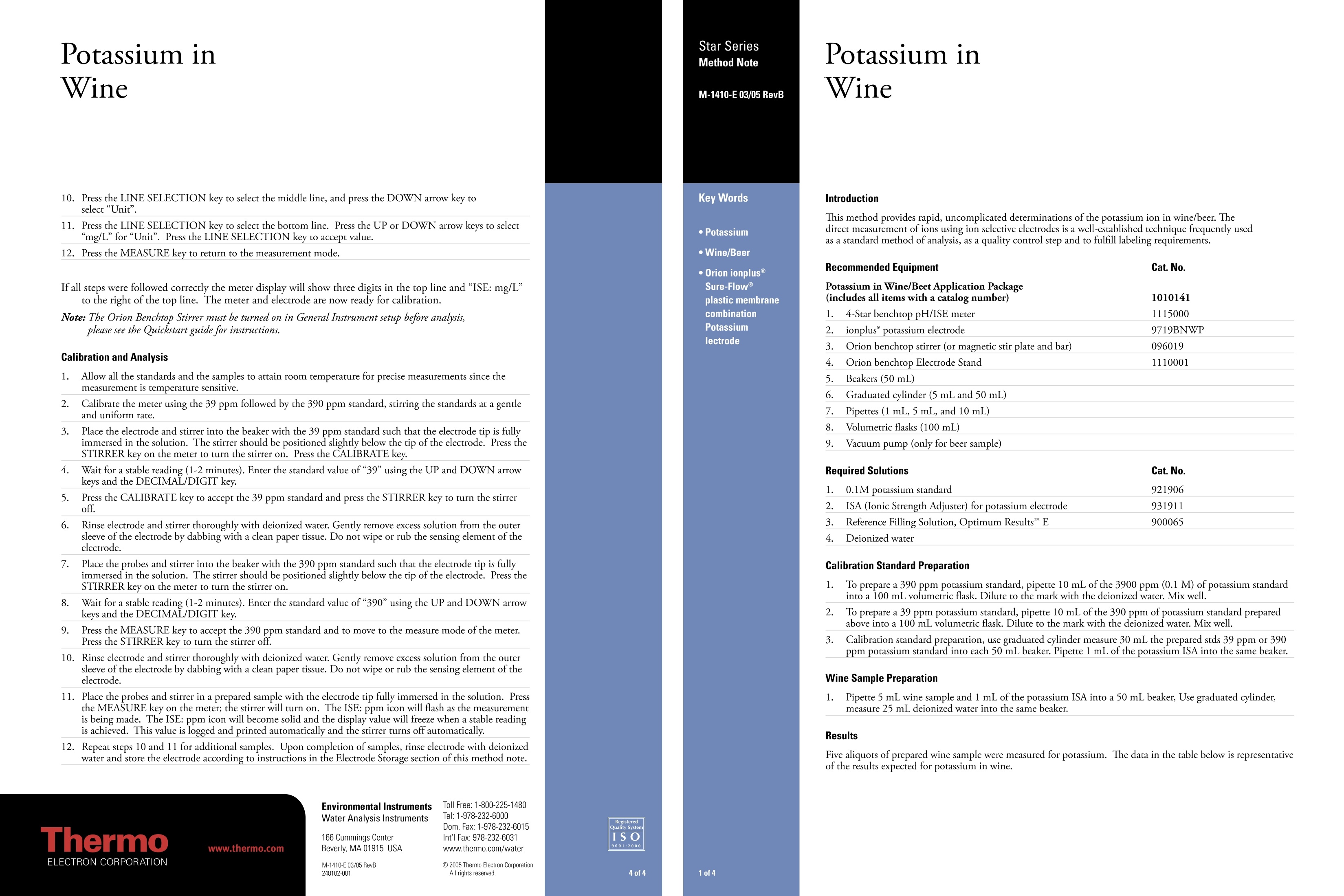
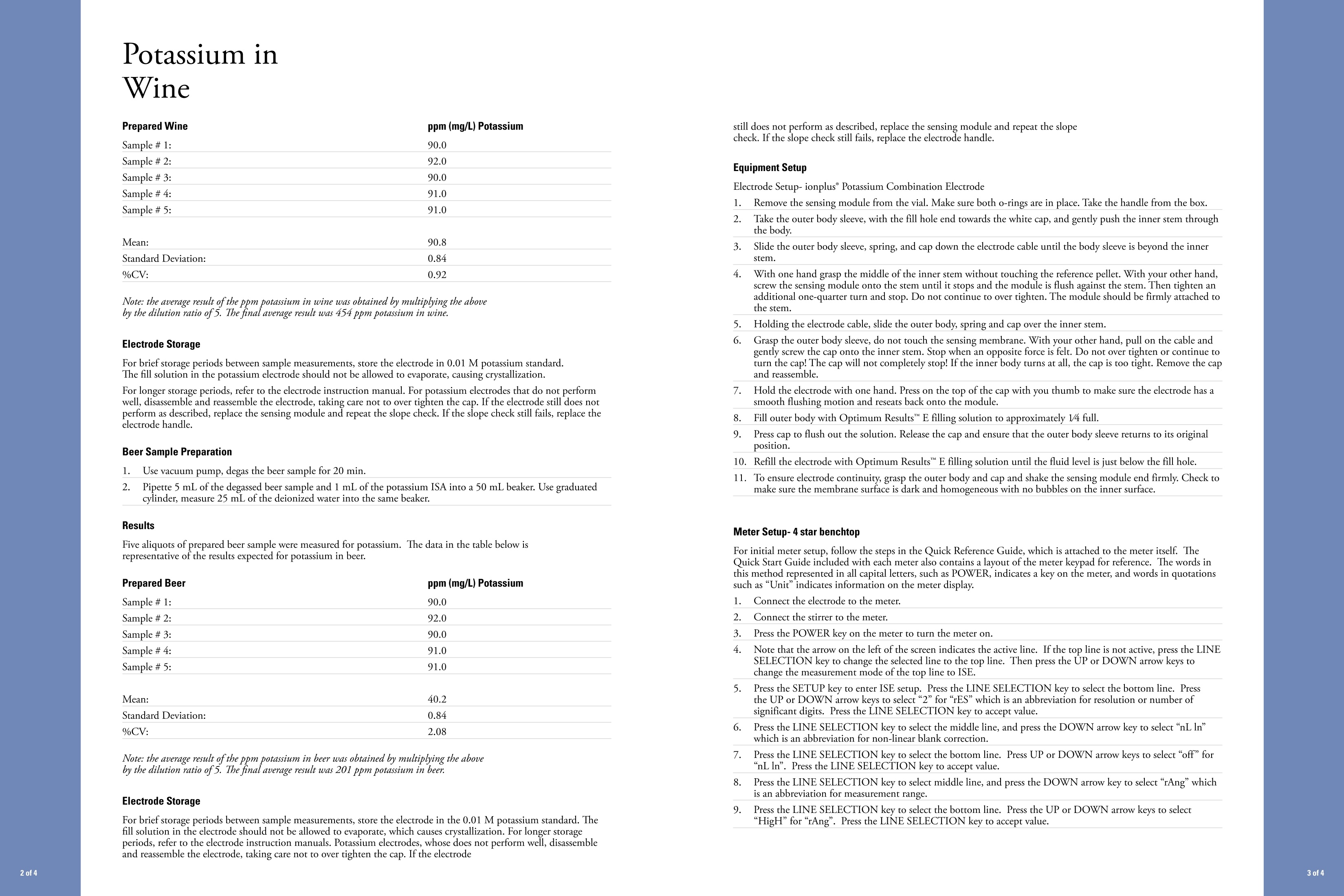
还剩1页未读,是否继续阅读?
赛默飞中国实验室产品事业部为您提供《啤酒中钾离子检测方案 》,该方案主要用于啤酒中理化分析检测,参考标准--,《啤酒中钾离子检测方案 》用到的仪器有台式pH/ORP/ISE/溶解氧/电导率测量仪、Orion 4-Star台式(便携式)pH/离子浓度测量仪
推荐专场
水质分析仪/多参数水质分析仪
更多
相关方案
更多
该厂商其他方案
更多











